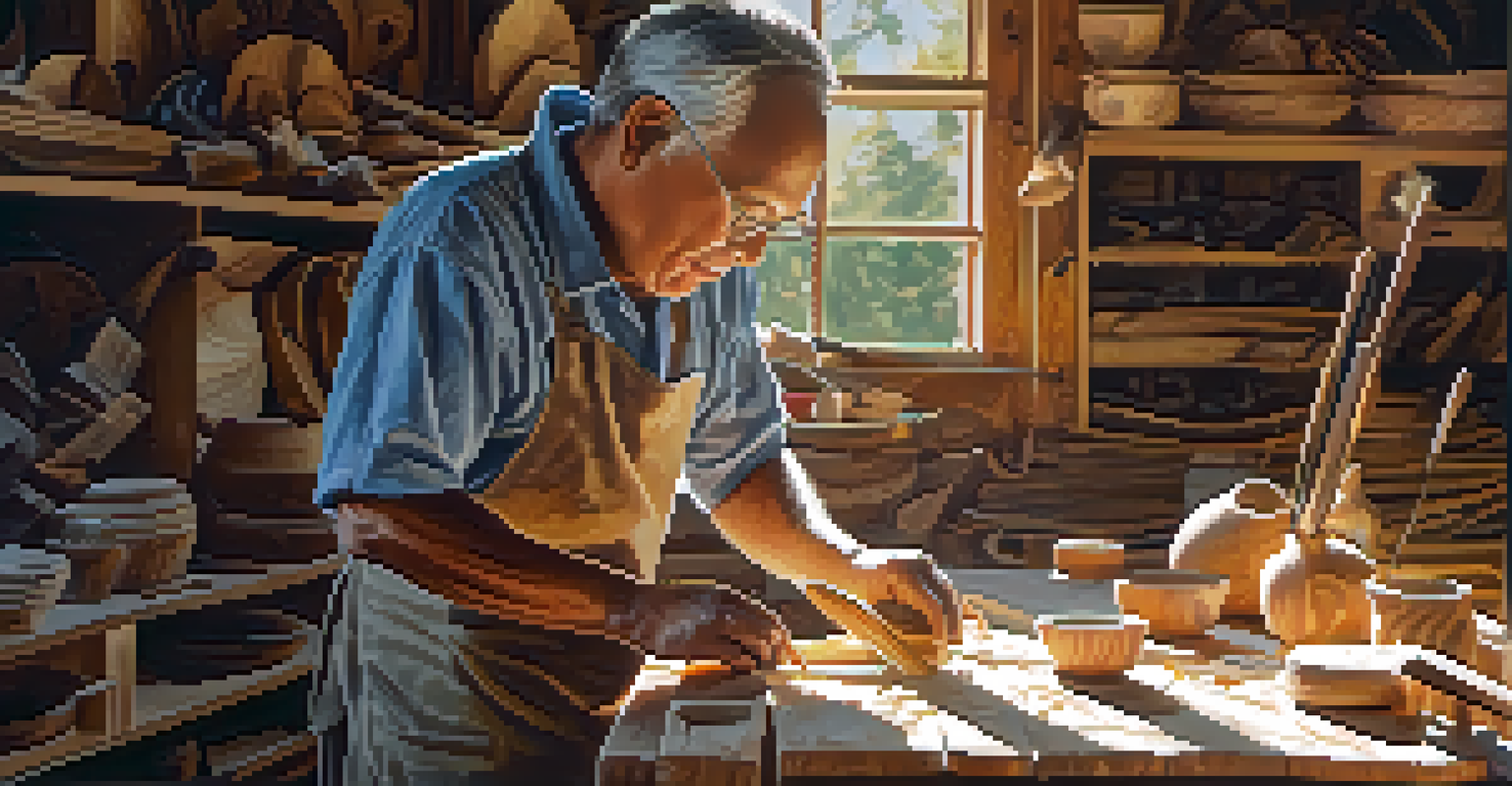Transcending Borders: Carving Techniques Across Continents

Understanding the Essence of Carving Across Cultures
Carving is more than just a technique; it's a storytelling medium. Across continents, cultures have used carving to express their identity, beliefs, and history. From the intricate woodwork of Africa to the delicate ivory carvings of Asia, each piece tells a story unique to its origin.
Art is the most beautiful of all lies; it is a means of expressing man's deepest thoughts and feelings.
Historically, carving has served practical purposes, such as creating tools and utensils, but it has evolved into an art form that transcends its utilitarian roots. This transformation highlights the cultural significance of carving, as artisans infuse their work with meaning, spirituality, and tradition.
Understanding these cultural contexts enriches our appreciation of carving techniques. It encourages us to see each piece not just as a decorative item, but as a reflection of a community's heritage and values.
African Carving: A Fusion of Function and Art
In Africa, carving is deeply intertwined with daily life and spiritual beliefs. Traditional African carvings often depict ancestral figures, animals, or symbols that convey important cultural narratives. Each region boasts distinct styles and materials, influenced by local resources and customs.

For example, the Baule people of Ivory Coast are renowned for their wooden sculptures that celebrate beauty and ancestry. These carvings serve not only as art but also as a means of preserving history and fostering community identity.
Carving as Cultural Storytelling
Carving serves as a powerful storytelling medium, reflecting the identity and history of various cultures around the world.
Additionally, contemporary African artists are blending traditional techniques with modern influences, creating a vibrant art scene that continues to evolve. This fusion allows for a dynamic expression of cultural identity that resonates with both local and global audiences.
Asian Carving: Precision and Spirituality Combined
Asian carving techniques often emphasize precision and spirituality, reflecting deep-rooted philosophies. In countries like China and Japan, artisans have honed their skills over centuries, producing intricate pieces that are steeped in tradition.
Every piece of art is a reflection of the culture it comes from, and carving is no exception.
Chinese jade carving, for example, is not only about creating beautiful objects but also about imbuing them with meaning. Each design element symbolizes virtues such as wisdom, purity, and longevity, making jade carvings treasured possessions.
Similarly, Japanese woodblock printing showcases meticulous carving techniques that produce stunning artworks. The process requires immense skill and patience, illustrating the dedication of artisans to their craft and the cultural significance of their work.
Indigenous Carving: Preserving Heritage Through Art
Indigenous cultures around the world have used carving as a vital means of preserving their heritage. From the totem poles of the Pacific Northwest to the intricate masks of the Maasai, each carving serves a purpose beyond aesthetics—it's a vessel for storytelling and cultural expression.
For instance, totem poles are not merely decorative; they represent clan lineages and historical events. Carving these poles requires not only skill but also a deep understanding of the stories they tell, ensuring that traditions are passed down through generations.
Blending Tradition with Modernity
Artists are merging traditional carving techniques with contemporary influences, creating innovative works that resonate globally.
As modern challenges threaten indigenous practices, many artisans are reviving traditional carving techniques to keep their cultures alive. This resurgence not only honors their ancestors but also educates others about the richness of their heritage.
European Carving: Blending Tradition with Innovation
Europe has a rich history of carving that spans various styles and periods, from Gothic cathedrals to Renaissance sculptures. Each era brought innovations and techniques that set the foundation for contemporary carving practices.
In Italy, for example, the mastery of marble carving reached its peak during the Renaissance, with artists like Michelangelo creating iconic sculptures that continue to inspire. The precision and detail involved in marble work demonstrate a blend of artistic vision and technical expertise.
Today, European carvers often explore a mix of traditional techniques and modern materials, pushing the boundaries of what carving can be. This evolution showcases the enduring appeal of carving as an art form that adapts while honoring its roots.
The Role of Technology in Modern Carving Techniques
With the advent of technology, traditional carving techniques have seen significant transformations. Tools such as CNC machines and laser cutters have introduced new possibilities, allowing artists to achieve precision and detail that was previously unattainable.
While some purists may argue that these technologies detract from the art form, many artisans embrace them as tools that enhance creativity. They can produce intricate designs and explore complex patterns, leading to innovative works that blend traditional craftsmanship with modern techniques.
Sustainability in Carving Practices
The future of carving emphasizes sustainability, with artisans prioritizing eco-friendly materials and innovative techniques to protect the environment.
Moreover, technology has made carving more accessible to aspiring artists, enabling them to experiment and develop their skills. This democratization of the art form is fostering a new generation of carvers who may draw inspiration from diverse global traditions.
Cultural Exchange: Carving Techniques in a Globalized World
In today's interconnected world, the exchange of carving techniques across cultures has become more prevalent. Artists are no longer confined to their regional styles; they are learning from one another and blending influences to create unique pieces.
For instance, a woodworker in the United States may adopt techniques from African carving traditions while incorporating elements of Asian aesthetics. This cultural fusion results in innovative works that reflect a global perspective, broadening the appeal of carving as an art form.

Such exchanges not only enrich the artists' practices but also promote cultural appreciation and understanding. As we share techniques and stories, we create a tapestry of artistic expression that transcends borders and fosters a sense of global community.
The Future of Carving: Sustainability and Innovation
As we look to the future, sustainability is becoming a crucial focus in carving practices. Many artisans are now prioritizing eco-friendly materials and techniques that minimize environmental impact, ensuring that their art respects the planet.
This shift towards sustainability is not just a trend; it reflects a growing awareness of our responsibility as creators. By using reclaimed wood or sustainable resources, artists can create beautiful pieces while contributing to the preservation of their environment.
Innovation will continue to play a significant role in shaping the future of carving. As artists experiment with new materials and techniques, the art form will evolve, embracing both tradition and contemporary practices that resonate with today's audiences.